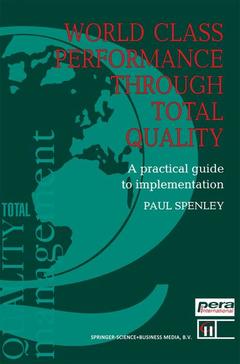Description
World Class Performance Through Total Quality, Softcover reprint of the original 1st ed. 1992
A practical guide to implementation
Author: Spenley Paul.
Language: English
Approximative price 52.74 €
In Print (Delivery period: 15 days).
Add to cart
Publication date: 11-2012
171 p. · 15.5x23.5 cm · Paperback
171 p. · 15.5x23.5 cm · Paperback
Description
/li>Contents
/li>
TOTAL QUALITY MANAGEMENT (TQM) - A COMPETITIVE EDGE In the context of the European and Western manufacturing challenge being set by the 'Far Eastern Machine', it is of critical importance that manufacturing competitiveness is improved in Western companies. The ability to export successfully is becoming even more critical to the economic well-being of developed countries worldwide. The Japanese domination of the motor cycle and domestic consumer markets has had a significant impact on the balance of payments in Western Europe and the USA. All the signs are that Japanese companies are ready and able to enter other markets aggressively, through takeovers, acquisitions and off-shore manufacturing facilities. In Western Europe, the creation of the 'Single Market' in 1992 has provided major opportunities for companies to increase their market share. Unfortunately, many companies in the West have shown an inability to succeed even in their market when faced with tough, well-organized opposition, such as that from the Far East. There is very little time left for Western companies to catch up - the challenge is becoming more fiercely competitive daily. The time to improve competitive edge may be too late for many companies, as the European frontiers are dismantled and the Japanese companies continue to build off-shore plants in Europe. For example, it is a fact that companies are increasingly x PREFACE being forced to achieve world class manufacturing capability in order to compete and, in many cases, survive.
One Introduction to Total Quality Management (TQM).- 1 — Total Quality Management — worldwide effect.- 2 — The management methodology.- 3 — TQM principles.- Two Implementation of TQM.- 4 — The executive/management role.- 5 — TQM structure and top-down requirements.- 6 — Quality policy.- 7 — Measurement.- 8 — Quality improvement teams.- 9 — Education and training.- 10 — Involvement and commitment.- 11 — Supplier strategy.- 12 — Time to market.- 13 — Organizational design.- 14 — Summary.- Three Tools and Techniques for TQM.
© 2024 LAVOISIER S.A.S.




